AP Biology Unit 4 - Cell Communication & Cell Cycle
1/50
There's no tags or description
Looks like no tags are added yet.
Name | Mastery | Learn | Test | Matching | Spaced |
|---|
No study sessions yet.
51 Terms
How do cells communicate with other cells?
Over short distances, cells communicate through direct contact or send out local regulator signals
Over long distances, cells release chemical signals to target cells
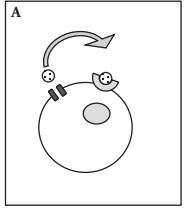
Autocrine Signaling
A type of cell communication where a cell secretes signaling molecules that bind to receptors on its own cell surface, leading to a response within the same cell
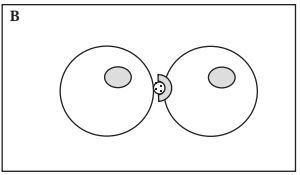
Juxtacrine Signaling
A type of cell communication where molecules are directly and adjacently transferred between cells through physical contact
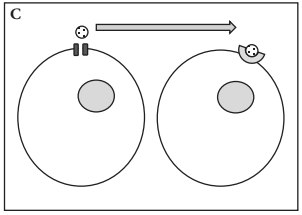
Paracrine Signaling
A type of cell communication where cells release signaling molecules to target nearby cells.
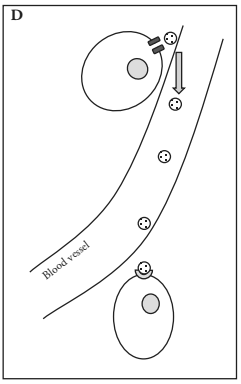
Endocrine Signaling
A type of cell communication where hormones are secreted into the bloodstream to target distant cells
Target Cell
Term for the cell receiving the signal
Ligand
The chemical messenger that attaches to the receptor protein of a target cell; must match the receptor of the protein
Three Main Kinds of Membrane Receptors
G protein-coupled, Tyrosine Kinases, Ion Channel
G Protein-Coupled Receptors (GPCRs)
Cell-surface receptors that work with the help of G protein, which binds it to its energy source: GTP
Receptor Tyrosine Kinases (RTKs)
Membrane receptors that attach phosphates to tyrosines and can trigger multiple signal transduction pathways; their abnormal functioning is associated with cancers
Ion Channel Receptors
Receptor that allows specific ions through a channel in the receptor, when a ligand binds to its; acts as a gate when the receptor changes shape
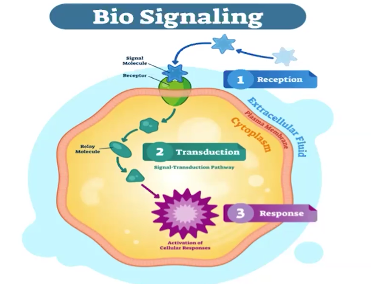
Signal Transduction Pathway
The three stages of cell communication- Reception, Transduction, and Response- with the objective of eliciting a cellular response (growth, secretion, gene expression)
Reception
The detection of a signal coming from outside a cell; when the receptor protein recognizes a ligand and specific chemical messenger
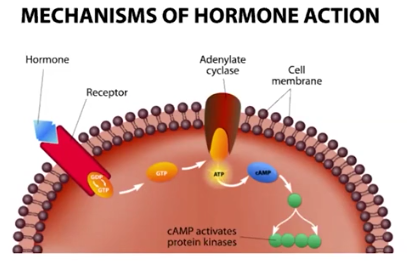
Transduction
The conversion of a signal to a form that can bring a cellular response; the binding of a ligand to its receptor, which causes a change in shape in the domain of the receptor and can activate a second messenger. This causes a signaling cascade, which amplifies the signal
Second Messengers (mainly Cyclic AMP/ cAMP or Calcium Ions)
Small, nonprotein, water-soluble molecules or ions that diffuse into a cell and, relay and amplify the signals of ligands; participate in pathways initiated by GPCRs and RTKs
Cyclic AMP (cAMP)
Most widely used second messenger that usually activate protein kinases to phosphorylate proteins
Adenylyl Cyclase
An enzyme in the plasma membrane that converts ATP to cAMP in response to a signal
Protein Modification
Occurs when a ligand binds to a receptor and has a role of activating a second messenger; also allows cells to regulate protein synthesis and the activity of cytoplasm proteins
Phosphorylation/ Signaling Cascades
Signaling pathways whose role is to enhance and amplify signals, which spread the signal to multiple cells and increase the chance of a cellular response
Response
The cellular response to the signal: gene expression, apoptosis, etc.
Gene Expression
A cellular response of signaling transduction pathways that alters the amount and type of protein produced in a cell; can cause a phenotype (trait change)
Apoptosis
A cellular response of signaling transduction pathways; the programmed death of cells
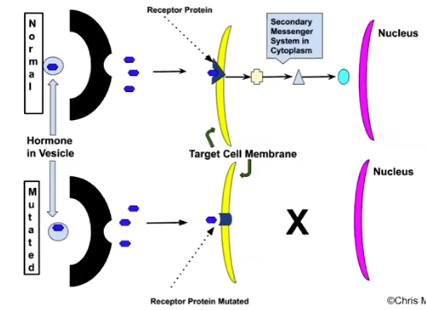
How do mutations in signaling pathways affect transduction?
Mutations in the receptor protein (ligand cannot fit) and changes of structure results in changes of function
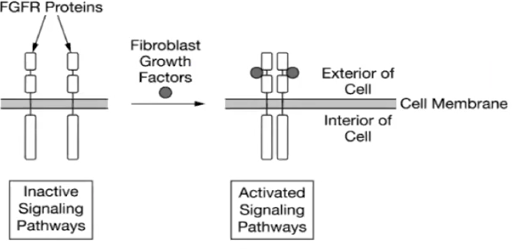
Activation of Pathway
Chemicals activate pathways by interfering with them and attaching to the receptor, which allows it to receive ligands
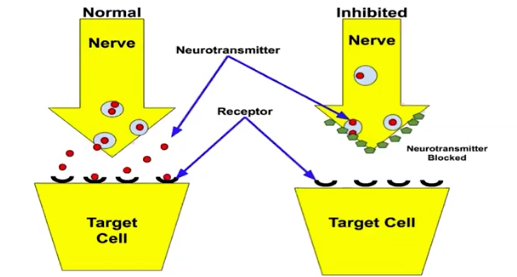
Inhibition of Pathway
Chemicals inhibit pathways by interfering with them by blocking ligands from being sent or blocking receptors from receiving ligands; results in no cellular response
Feedback Mechanisms
Processes that maintain homeostasis by increasing or decreasing a cellular response

Negative Feedback Mechanisms
Maintain homeostasis by returning the system back to its target set point
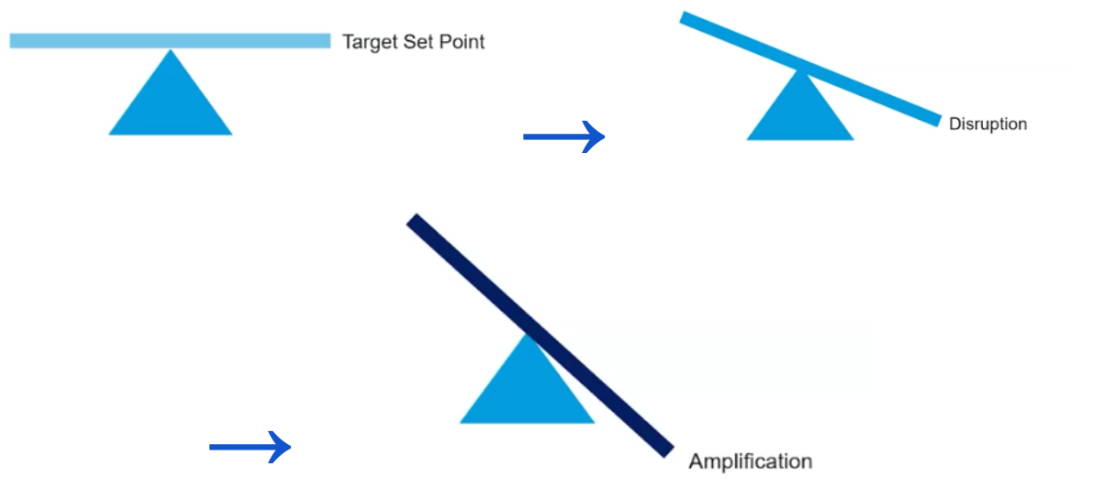
Positive Feedback Mechanisms
Disrupt homeostasis to amplify responses and processes; moves the cellular response farther away from its set point to initiate an additional response
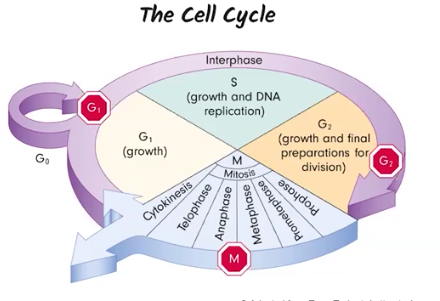
The Cell Cycle
Two highly regulated processes- Interphase and M-Phase- that are responsible for the growth and reproduction of cells
Interphase
The primary process of the cell cycle, where the cell undergoes growth and preparation for cell division; includes three stages G1, S, & G2
G1 Stage
The first stage of interphase where cell growth occurs
S Stage
The second stage of interphase where DNA is copied to provide a sufficient amount of DNA for cell division
G2 Stage
The final stage of interphase where cytoplasmic components are doubled to prepare for cell division
M-Phase
The secondary process of the cell cycle where the cell undergoes 1) Mitosis & 2) Cytokinesis
Mitosis
The 4-step and primary part of the M-Phase where cells are divided and genomes are transferred from a parent to identical daughter cells; plays a role in growth, tissue repair, and asexual reproduction
Prophase
Metaphase
Anaphase
Telophase
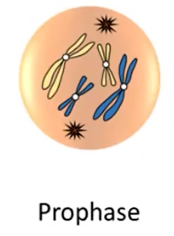
Prophase
The nuclear envelope begin to disappear, which allows DNA to coil into chromosomes and move towards the center of the cell
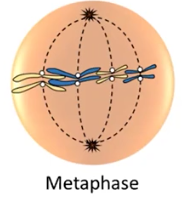
Metaphase
Fibers aline double chromosomes across the center of the cell
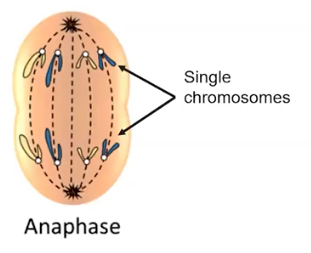
Anaphase
Fibers separate double chromosomes into single chromosomes (chromatids) at the centromere. The chromatids then migrate to opposite ends of the cell

Telophase
The nuclear envelope reappears and establishes two separate nuclei
Cytokinesis
The secondary part of the M-Phase that separates the cytoplasm of the two cells and completes the asexual reproduction of cells
G0 Phase
A resting gap for cells where cell division no longer occurs
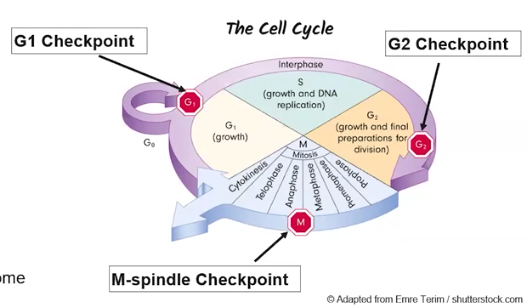
Cycle Cycle Checkpoints
Control mechanisms that are responsible for regulating progression through the cell cycle; there are four checkpoints
G1
S
G2
M-Spindle
G1 Checkpoint
Checks cell size, nutrients, growth factor, and for potential DNA damage at the end of the G1 phase
S Checkpoint
Checks for proper replication and for potential DNA damage at the end of the S phase
G2 Checkpoint
Checks for proper DNA replication and for potential DNA damage at the end of the G2 phase
M-Spindle Checkpoint
Checks for proper fiber attachment to chromosomes in the M-Phase
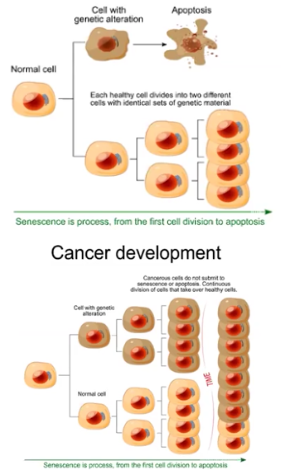
What happens if the cell cycle is disrupted?
Disruptions can cause cancer or apoptosis.
*Cancer is caused by an unregulated cell cycle
Cyclines
A group of proteins that are produced to promote cell cycle progression and degraded to inhibit cell cycle progression; used to activate CDKS
Cyclin-Dependent Kinases (CDKs)
A group of enzymes that require cyclin-binding for activation to phosphorylate substrates and promote cell cycle activities
Mitosis-Promoting Factor (MPF)
A cyclin-CDK complex that is responsible for promoting mitosis; created by a Cyclin and CDK binding

Cyclin, CDK, & MPF Cycle
G1-S Stages: Cyclin Concentration Builds
G2 Stage: Cyclin bonds to CDK to make MPF
M-Phase: Cyclin degrades
*CDK is always there